(Click on any image below for a larger version)
Monday, January 22: Cape
Lookout, Elephant Island, page 1
The ship hauled up its anchor and set sail for Cape Lookout on
the other side of Elephant Island, where we would make our first
actual landing in the Antarctic. I could see bergie bits floating
on the water outside my stateroom window as we cruised around the
island.
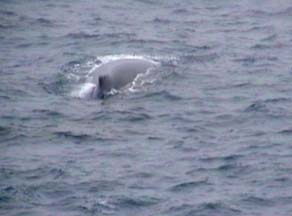 A Humpback
Whale was spotted in the water near the ship. Captain Notke
steered the ship in a circle to give the passengers a good chance
to see the whale. It blew and surfaced repeatedly for several
minutes. As we watched for the whale from the stern of the ship
we heard the crowd at the bow give a shout in unison. Geoff Green
announced over the loudspeakers that the whale had just breached
directly in front of the ship.
A Humpback
Whale was spotted in the water near the ship. Captain Notke
steered the ship in a circle to give the passengers a good chance
to see the whale. It blew and surfaced repeatedly for several
minutes. As we watched for the whale from the stern of the ship
we heard the crowd at the bow give a shout in unison. Geoff Green
announced over the loudspeakers that the whale had just breached
directly in front of the ship.
Visit the American Cetacean Society fact sheet
about the Humpback Whale.
The Marine Mammal Center also has information
about the Humpback
Whale.
We passed a huge glacier as we neared Cape Lookout.
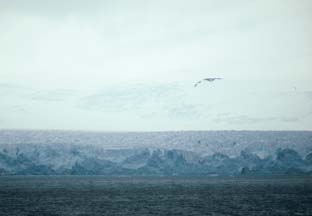 The old ice at the base of the glacier was deep blue in color.
The blue ice was overlain by an accumulation of white snow and
young ice. The top of the glacier was a maze of crevasses.
The old ice at the base of the glacier was deep blue in color.
The blue ice was overlain by an accumulation of white snow and
young ice. The top of the glacier was a maze of crevasses.
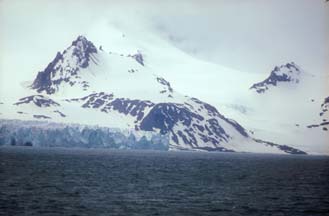 The front of the glacier was miles across and it extended well
out into the harbor.
The front of the glacier was miles across and it extended well
out into the harbor.
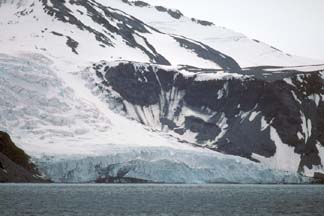
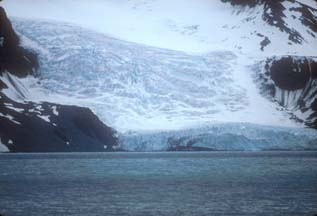 There was a glacier in every valley on the island.
There was a glacier in every valley on the island.
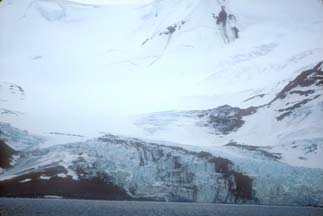 The valleys were so steep that the glaciers were broken into
jumbled icefalls, slowly tumbling their way down to sea level.
The valleys were so steep that the glaciers were broken into
jumbled icefalls, slowly tumbling their way down to sea level.
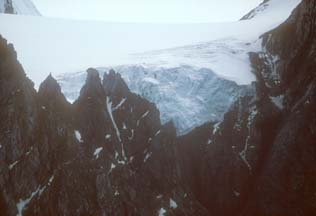 Glaciers were perched on the tops of the
mountains, with their broken faces suspended over a few thousand
feet of steep, rocky cliffs. Any ice that broke away from those
glaciers had a long drop ahead of it.
Glaciers were perched on the tops of the
mountains, with their broken faces suspended over a few thousand
feet of steep, rocky cliffs. Any ice that broke away from those
glaciers had a long drop ahead of it.
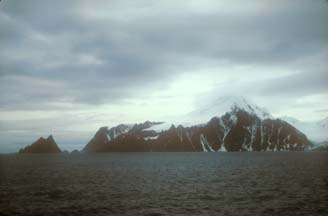 Cape Lookout is marked by a craggy,
pyramid-shaped island separated from the shore by a narrow
strait.
Cape Lookout is marked by a craggy,
pyramid-shaped island separated from the shore by a narrow
strait.
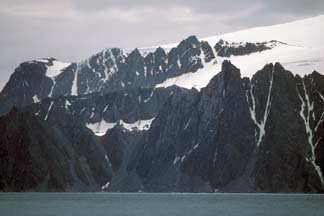
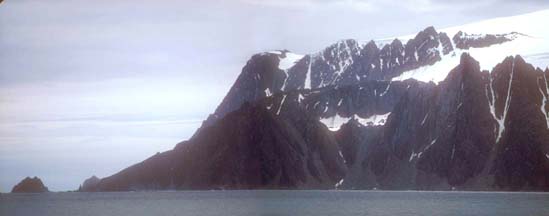 We would land on the low spit of
land at the left.
We would land on the low spit of
land at the left.
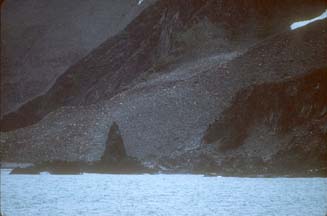 The cape is the site of another large Chinstrap Penguin rookery.
The lighter slopes in this picture are stained by pink Chinstrap
Penguin guano.
The cape is the site of another large Chinstrap Penguin rookery.
The lighter slopes in this picture are stained by pink Chinstrap
Penguin guano.
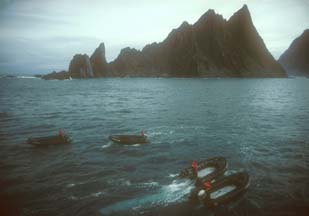 The
ship's staff prepared the Zodiacs for our first landing in
Antarctica.
The
ship's staff prepared the Zodiacs for our first landing in
Antarctica.
The Zodiac brought us to shore on a narrow, cobblestone spit
connecting a rock outcrop to the main island.
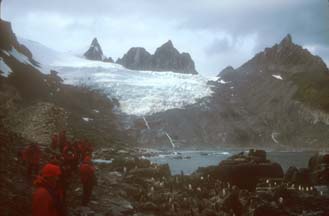 The expedition members kept to a narrow path alongside the
rookery.
The expedition members kept to a narrow path alongside the
rookery.
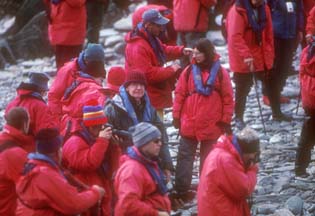 Once again, Dad proved that he was not a slave
to fashion.
Once again, Dad proved that he was not a slave
to fashion.
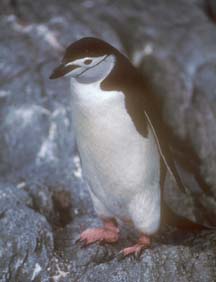 Chinstrap Penguins are easily distinguished by
the narrow black stripe under the white face.
Chinstrap Penguins are easily distinguished by
the narrow black stripe under the white face.
Background information about the Chinstrap Penguin.
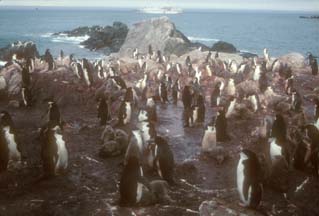 The Chinstrap Penguin rookery was thickly
coated in pink penguin guano. The constant dampness supported a
thick, old fish market kind of odor.
The Chinstrap Penguin rookery was thickly
coated in pink penguin guano. The constant dampness supported a
thick, old fish market kind of odor.
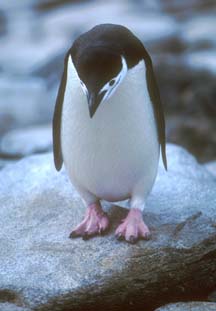 Dirty Chinstrap Penguins were constantly waddling into the water
as clean penguins were hauling themselves onto land along the
spit.
Dirty Chinstrap Penguins were constantly waddling into the water
as clean penguins were hauling themselves onto land along the
spit.
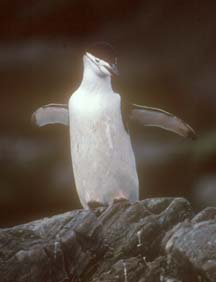 The air was filled with the constant display cries of male
penguins looking for mates.
The air was filled with the constant display cries of male
penguins looking for mates.
 Hear the Chinstrap Penguins.
Hear the Chinstrap Penguins.
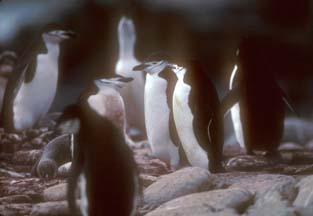 "I don't know. Where do you want to go for
dinner?"
"I don't know. Where do you want to go for
dinner?"
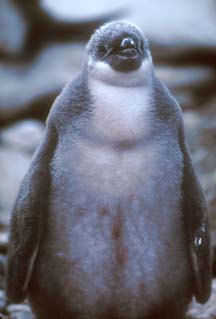 Chinstrap Penguin chicks sat waiting patiently
for their parents to return with food.
Chinstrap Penguin chicks sat waiting patiently
for their parents to return with food.
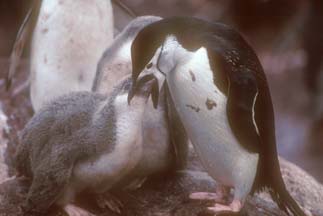 Chick feeding was a constant
operation in the rookery. The gray chicks tickled the beaks of
the adults to trigger a regurgitation of the krill stored in
their crops. It was possible to see the pink, shrimp-like
crustaceans come up into the mouths of the adults before the
chicks reached in to grab them. Krill grow to be nearly two
inches long, and large krill wouldn't look out of place on a
cocktail shrimp platter.
Chick feeding was a constant
operation in the rookery. The gray chicks tickled the beaks of
the adults to trigger a regurgitation of the krill stored in
their crops. It was possible to see the pink, shrimp-like
crustaceans come up into the mouths of the adults before the
chicks reached in to grab them. Krill grow to be nearly two
inches long, and large krill wouldn't look out of place on a
cocktail shrimp platter.
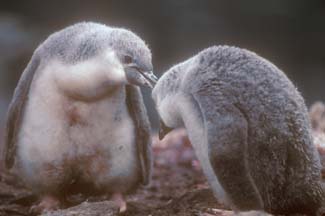 The downy chicks accumulated a crust of guano
on the lower parts of their bodies.
The downy chicks accumulated a crust of guano
on the lower parts of their bodies.
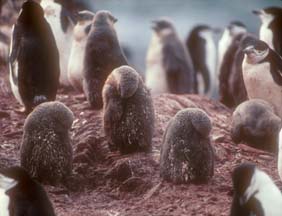 The Chinstrap Penguin chicks rested their heads
behind their wings as they napped.
The Chinstrap Penguin chicks rested their heads
behind their wings as they napped.
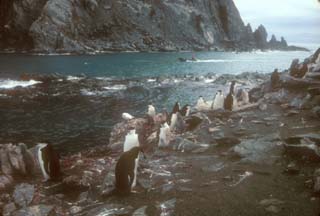 The penguins paid scant attention to the
Zodiacs cruising through the strait.
The penguins paid scant attention to the
Zodiacs cruising through the strait.
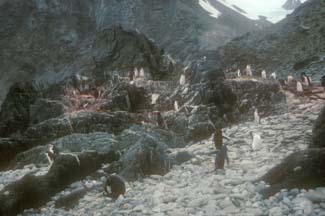 The flat areas near the rocky outcrop were
covered in penguins. Other penguins had to climb to higher ground
to find a place to raise their chicks.
The flat areas near the rocky outcrop were
covered in penguins. Other penguins had to climb to higher ground
to find a place to raise their chicks.
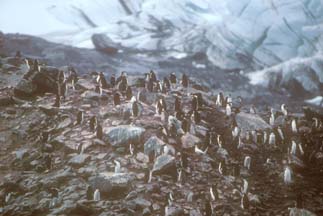 Some of them climbed several hundred feet up
the slope to find their chicks.
Some of them climbed several hundred feet up
the slope to find their chicks.
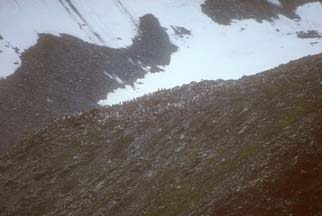 It must take hours for some of them to climb up
to their chicks on the mountainside above the cape.
It must take hours for some of them to climb up
to their chicks on the mountainside above the cape.
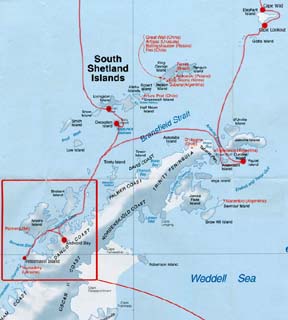 Map of the Antarctic Peninsula.
Map of the Antarctic Peninsula.
Send a message to Brian.
 A Humpback
Whale was spotted in the water near the ship. Captain Notke
steered the ship in a circle to give the passengers a good chance
to see the whale. It blew and surfaced repeatedly for several
minutes. As we watched for the whale from the stern of the ship
we heard the crowd at the bow give a shout in unison. Geoff Green
announced over the loudspeakers that the whale had just breached
directly in front of the ship.
A Humpback
Whale was spotted in the water near the ship. Captain Notke
steered the ship in a circle to give the passengers a good chance
to see the whale. It blew and surfaced repeatedly for several
minutes. As we watched for the whale from the stern of the ship
we heard the crowd at the bow give a shout in unison. Geoff Green
announced over the loudspeakers that the whale had just breached
directly in front of the ship.
















 Hear the Chinstrap Penguins.
Hear the Chinstrap Penguins.









 Table of
Contents
Table of
Contents